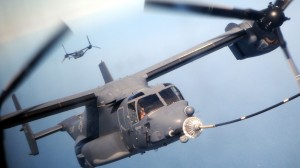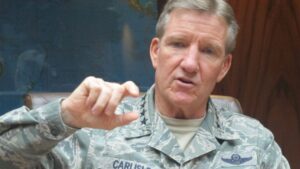Gen. Carlisle Says A-10 Retirement May Slide 2 To 3 Years
Posted on
WASHINGTON: Sen. Kelly Ayotte, take note. The head of Air Combat Command told reporters this morning that the A-10 Warthog’s retirement will probably slide two to three years thanks to the increased threats faced by the Air Force.
Gen. Hawk Carlisle, speaking at a Defense Writers Group breakfast, made it clear the decision hasn’t been made officially and must be approved by Air Force Secretary Deborah Lee James and Chief of Staff Gen. Mark Welsh. But as anyone who’s dealt with the Pentagon for a long time knows, it’s unlikely a four-star general would speak publicly about such a sensitive issue unless the decision was pretty much a slam dunk.
The debate about the A-10 has been dominated by discussions about its past performance in theaters where the aircraft does not face serious threats from surface-to-air missiles or advanced fighter aircraft. Carlisle and all the senior leadership of the Air Force (as well as F-35 pilots) say that the A-10 is too vulnerable to advanced threats to be useful in a major conflict. Even in the low-threat environments where the A-10 has been used most of the last 15 years, the A-10 has not been the dominant Close Air Support weapon. More than 80 percent of CAS missions have actually been carried out by B-1 bombers, F-15s, F-16s and F-18s. What’s unique about the A-10 is that it’s the only US aircraft exclusively built for the Close Air Support mission; it was originally intended to kill lots of Soviet tanks as they flooded through the Fulda Gap
The Air Force has wanted to retire the A-10 for several years to save an estimated $3.7 billion, but a small cadre of lawmakers stood against it, led by Sen. Ayotte, whose husband is a former A-10 pilot. Also, Sen. John McCain, chairman of the Senate Armed Services Committee, has strong feelings about the A-10, many of which happen to be based at Davis-Monthan Air Base in his home state of Arizona.
Carlisle, who recommended sending A-10s to Incirlik, Turkey to help — as the phrase goes — “to degrade and destroy ISIL” — made it clear the need for combat air patrol missions in Syria, Iraq, Afghanistan combined with the rising threat from Russia and the need for global presence made it necessary to hold off on retiring the A-10 fleet.
 Carlisle, who indicated that deconfliction efforts between US and Russian forces over Syria had improved since the Russians dropped by our embassy in Iraq to tell us they were going to start flying in an hour, declined to answer my question about whether Russian jets had painted US with their targeting radar. We would, he said, have to go up a few levels in classification to answer that one. That may indicate that the Russians have used their targeting radar, which is generally regarded as a serious threat in a peacetime environment.
Carlisle, who indicated that deconfliction efforts between US and Russian forces over Syria had improved since the Russians dropped by our embassy in Iraq to tell us they were going to start flying in an hour, declined to answer my question about whether Russian jets had painted US with their targeting radar. We would, he said, have to go up a few levels in classification to answer that one. That may indicate that the Russians have used their targeting radar, which is generally regarded as a serious threat in a peacetime environment.
Carlisle also voiced support for V-22s to perform long-range search and rescue missions to supplement the 112 Combat Rescue Helicopters the service is buying. He said the best approach would be to boost the Air Force Special Operations (AFSOC) fleet and “share” the V-22s when needed. However, there’s no money for this yet and the general made clear he’s talking about something he’d like to be able to do.
Subscribe to our newsletter
Promotions, new products and sales. Directly to your inbox.


